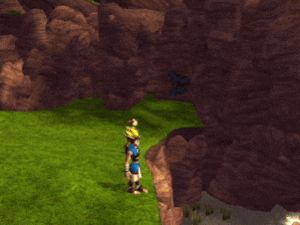Boosted Uppercut: Difference between revisions
No edit summary |
|||
| Line 1: | Line 1: | ||
[[File:Boosted Uppercut.gif|thumb|A boosted uppercut being performed in Sentinel Beach]] | [[File:Boosted Uppercut.gif|thumb|A boosted uppercut being performed in Sentinel Beach]] | ||
= Traditional = | = Traditional = | ||
A '''boosted uppercut''' or | A '''boosted uppercut''', or '''boosted''', is a movement technique that gives Jak much more horizontal momentum than the conventional intended movement techniques, making it possible to cross larger gaps. The technique has a few methods by which it can be performed, all of which yield increased horizontal momentum: | ||
* by slowly walking off of a ledge and pressing square, cross, circle in succession before Jak begins his falling animation; | * by slowly walking off of a ledge and pressing square, cross, circle in succession before Jak begins his falling animation; | ||
Revision as of 19:41, 7 July 2024

Traditional
A boosted uppercut, or boosted, is a movement technique that gives Jak much more horizontal momentum than the conventional intended movement techniques, making it possible to cross larger gaps. The technique has a few methods by which it can be performed, all of which yield increased horizontal momentum:
- by slowly walking off of a ledge and pressing square, cross, circle in succession before Jak begins his falling animation;
- by running along the edge of a ledge, and then pressing square, cross, circle in succession (often called a sideways boosted);
- by standing on the very edge of a ledge so that Jak's feet point downwards, and then pressing square, cross, circle in succession;
- In Jak and Daxter: The Precursor Legacy only, by zoom walking off of a ledge, then cancelling the goggles with triangle and quickly pressing square, cross, circle in succession.
Boosted uppercuts can be performed in Jak and Daxter: The Precursor Legacy, Jak II, and Jak 3.
Tutorial
Technical
When Jak walks off a ledge, he enters a collision mode called low-coverage. When in this mode, Jak's surface is changed to *edge-surface* which has lower than normal friction. Performing a punch uppercut while in this low friction mode results in a lot more momentum than normal friction.
Note that this is also why ice boosteds, or super boosteds, work. The friction value for *ice-surface* is even lower. However, if you fall off an edge of ice, you'll get switched back to *edge-surface* and get a normal boosted uppercut instead.
*edge-surface* Values
(let ((v1-39 (new 'static 'surface
:name '*edge-surface*
:turnv 1.0
:turnvv 1.0
:tiltv 1.0
:tiltvv 1.0
:transv-max 1.0
:target-speed 1.0
:seek0 153600.0
:seek90 153600.0
:seek180 256000.0
:fric 30720.0
:nonlin-fric-dist 5120.0
:slip-factor 1.0
:slope-down-factor 18432.0
:slope-slip-angle 8192.0
:bend-factor 0.8
:bend-speed 4.0
:alignv 1.0
:align-speed 1.0
:turnvf 1.0
:turnvvf 1.0
:tiltvf 1.0
:tiltvvf 1.0
:vel-turn 1.0
)
)
)
(set! *edge-surface* v1-39)
(set! (-> v1-39 exit-hook) nothing)
(set! (-> v1-39 mult-hook) (the-as (function surface surface surface int none) nothing))
(set! (-> v1-39 touch-hook) nothing)
(set! (-> v1-39 active-hook) nothing)
)
Discovery
The Backwards Boosted Uppercut was the first variant of the Boosted Uppercut to be discovered. Backwards Boosted Uppercuts regularly occur in casual play which makes it impossible to determine when it was first performed. A speedrunner named Meggachilly discovered the Boosted Uppercut that is still used in Jak and Daxter speedruns today.
TLF Boosted
There is a movement technique in Jak and Daxter: The Lost Frontier that is similar to a boosted uppercut, but is not entirely the same. By uppercutting off of a ledge and rotating the camera, Jak is able to gain more horizontal distance than intended, hence why it is referred to as a boosted uppercut.